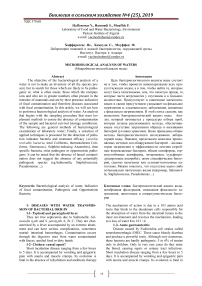Microbiological analysis of waters
Автор: Haffaressas Y., Hamoudi S., Mouffok F.
Журнал: Биология в сельском хозяйстве @biology-in-agriculture
Рубрика: Современные вопросы микробиологии и биобезопасности окружающей среды
Статья в выпуске: 4 (25), 2019 года.
Бесплатный доступ
The objective of the bacteriological analysis of a water is not to make an inventory of all the species present, but to search for those which are likely to be pathogenic or, what is often easier, those which the companions and who are in greater numbers often present in the intestine of mammals and are by their presence indicative of fecal contamination and therefore diseases associated with fecal contamination. In this article, we will see how to perform a bacteriological analysis of water. An analysis that begins with the sampling procedure that must implement methods to ensure the absence of contamination of the sample and bacterial survival (storage conditions). The following are general methods of bacteriological examination of laboratory water; Finally, a selection of applied techniques is presented for the detection of pollution indicator bacteria and treatment efficacy (Aerobic revivable bacteria , total Coliforms, thermotolerant Coliforms, Enterococci, Sulphito-reducing Anaerobes), then specific bacteria, strict pathogens or opportunistic pathogens. It can be noted that the absence of faecal contamination does not suggest the absence of any potentially pathogenic species (eg.Salmonella, Staphylococcus, Pseudomonas ...).
Bacteriological analysis of water, indicative of fecal contamination, pathogenic and opportunistic bacteria
Короткий адрес: https://sciup.org/147230996
IDR: 147230996 | УДК: 579.68
Список литературы Microbiological analysis of waters
- Clausen E.M. Fecal streptococci: indicators of pollution/ Clausen E.M. [et al.] // American Society for Testing and Materials, ASTM STP 635. -1977. - P.247-264.
- DELARRAS C. Surveillance sanitaire et microbi-ologique des eaux : réglementation, prélèvements, analyses/ DELARRAS C. [et al.] // Editions Tec et Doc-EM Inter. -2003.
- DELARRAS C. Surveillance sanitaire et microbi-ologique des eaux/ DELARRAS C. [et al.] // LAVOISIER TEC & Doc. -2003.
- DELARRAS C. Microbiologie pratique pour le laboratoire d'analyses ou de contrôle sanitaire/ DELARRAS C. [et al.] // Editions Tec et Doc-EM Inter-Lavoisier. -2007.
- DELAY M. La gestion des aquifères/ DELAY M. [et al.] // MASSON. - 1997.
- DELCOURTM.O. Equilibres chimiques en solution/ DELCOURT M.O. [et al.] // De Boeck Université. -2 000.
- DESJARDINS C. Le traitement des eaux/ DESJARDINS C. [et al.] // LAVOISIER TEC & Doc. -1997.
- DESJARDINS R. Le traitement des eaux/ DESJARDINS C. [et al.] // Presses Internationales Polytechniques. 2e édition. - 1997.
- Edberg S.C. Escherichia coli: the best biological drinking water indicator for public health protection/ Edberg S.C. [et al.] // Journal of Applied Microbiology. -2000. -Vol.88. -P. 106-116.
- Elmund G.K. Comparison of Escherichia coli, total coliform and fecal coliform populations as indicators of wastewater treatment efficiency/ Elmund G.K. [et al.] // Water Environment Research. -1999. -Vol.71. - P.332-339.
- Gleeson C. The coliform index and waterborne dis-ease/ Gleeson C. [et al.] // E & FN Spoon. -1997. -P.194.
- HASLAY C. Microbiologie des eaux d'alimentation/ HASLAY C. [et al.] // Technique et Documentation. - 1993.
- LARPENT J. P. Mémento technique de microbiolo-gie/ LARPENT J. P. [et al.] // Technique et Documentation. -1990.
- MARTIN G Point sur l'épuration et le traitement des effluents (Eau/Air)/ MARTIN G. [et al.] // Tec et Doc. Bactériologie des milieux aquatiques. -1985. -Vol.2.
- Olivieri V.P. Bacterial indicators of pollution/ Olivieri VP. [et al.] // Bacterial indicators of pollution, CRC Press. -1982. -P.21-41.
- Rodier J. L'Analyse de l'eau / Rodier J. [et al.] // Dunod 9e édition. - 2009. -1579P.


